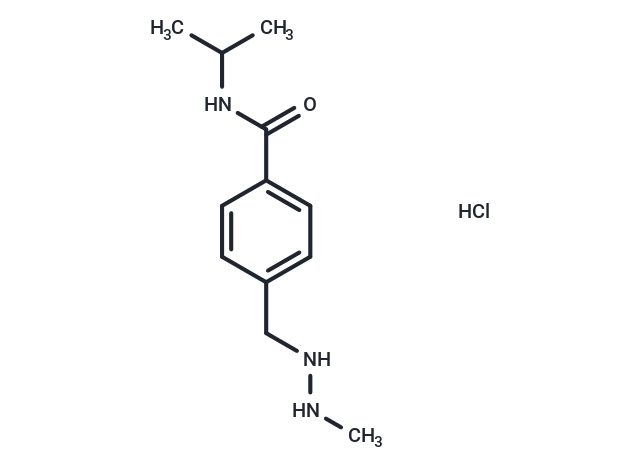Shopping Cart
- Remove All
 Your shopping cart is currently empty
Your shopping cart is currently empty

Procarbazine hydrochloride (NSC-77213 HCl) is the hydrochloride salt of a methylhydrazine derivative with antineoplastic and mutagenic activities. Although the exact mode of cytotoxicity has not been elucidated, procarbazine, after metabolic activation, appears to inhibit the trans-methylation of methionine into transfer RNA (t-RNA), thereby preventing protein synthesis and consequently DNA and RNA synthesis. This agent may also undergo auto-oxidation, resulting in the formation of cytotoxic free radicals which damage DNA through an alkylation reaction.

| Pack Size | Price | Availability | Quantity |
|---|---|---|---|
| 50 mg | $30 | In Stock | |
| 100 mg | $39 | In Stock | |
| 500 mg | $84 | In Stock | |
| 1 g | $122 | In Stock | |
| 1 mL x 10 mM (in DMSO) | $43 | In Stock |
| Description | Procarbazine hydrochloride (NSC-77213 HCl) is the hydrochloride salt of a methylhydrazine derivative with antineoplastic and mutagenic activities. Although the exact mode of cytotoxicity has not been elucidated, procarbazine, after metabolic activation, appears to inhibit the trans-methylation of methionine into transfer RNA (t-RNA), thereby preventing protein synthesis and consequently DNA and RNA synthesis. This agent may also undergo auto-oxidation, resulting in the formation of cytotoxic free radicals which damage DNA through an alkylation reaction. |
| In vitro | Procarbazine plus Cu(II) induce piperidine-labile and formamidopyrimidine-DNA glycosylase-sensitive lesions at the 5'-ACG-3' sequence, complementary to a hotspot of the p53 gene, and the 5'-TG-3' sequence. Procarbazine causes DNA damage through non-enzymatic formation of the Cu(I)-hydroperoxo complex and methyl radicals. [1] Procarbazine has a strong clastogenic effect in hematopoietic cells and is mutagenic in a variety organs after high dose treatment. [2] |
| In vivo | Procarbazine causes significant decrease in testicular and epididymal weight and a drastic reduction in haploid cells and spermatogenic arrest, demonstrating variation among the test golden hamster. [3] Procarbazine produces a dose-dependent potentiation of MAO A in brown adipose tissue, the elevation being more pronounced following monomethylhydrazine, with activity rising to 350% of that in control homogenates in rats. Procarbazine or monomethylhydrazine reduces metabolism of this amine by a similar degree as had been determined ex-vivo in blood vessel homogenates. [4] Procarbazine is mutagenic, clastogenic and teratogenic in a wide range of test systems of varying complexity and a wide-spectrum carcinogen in rodents and monkeys, causing tumours of the haemopoietic system, the mammary gland, the lung and the nervous system. Procarbazine in vivo undergoes a complex series of metabolic changes that result in the generation of a number of chemically reactive species, including methylating agents and free radicals. [5] |
| Alias | Procarbazine HCl, NSC-77213 HCl |
| Molecular Weight | 257.76 |
| Formula | C12H19N3O·HCl |
| Cas No. | 366-70-1 |
| Smiles | c1(C(=O)NC(C)C)ccc(cc1)CNNC.Cl |
| Relative Density. | 8.3 g/cm3 |
| Storage | Powder: -20°C for 3 years | In solvent: -80°C for 1 year | Shipping with blue ice. | ||||||||||||||||||||||||||||||||||||||||
| Solubility Information | H2O: 48 mg/mL (186.22 mM), Sonication is recommended. DMSO: 45 mg/mL (174.58 mM), Sonication is recommended. Ethanol: 22 mg/mL (85.35 mM), Sonication is recommended. | ||||||||||||||||||||||||||||||||||||||||
Solution Preparation Table | |||||||||||||||||||||||||||||||||||||||||
Ethanol/DMSO/H2O
DMSO/H2O
| |||||||||||||||||||||||||||||||||||||||||

Copyright © 2015-2025 TargetMol Chemicals Inc. All Rights Reserved.